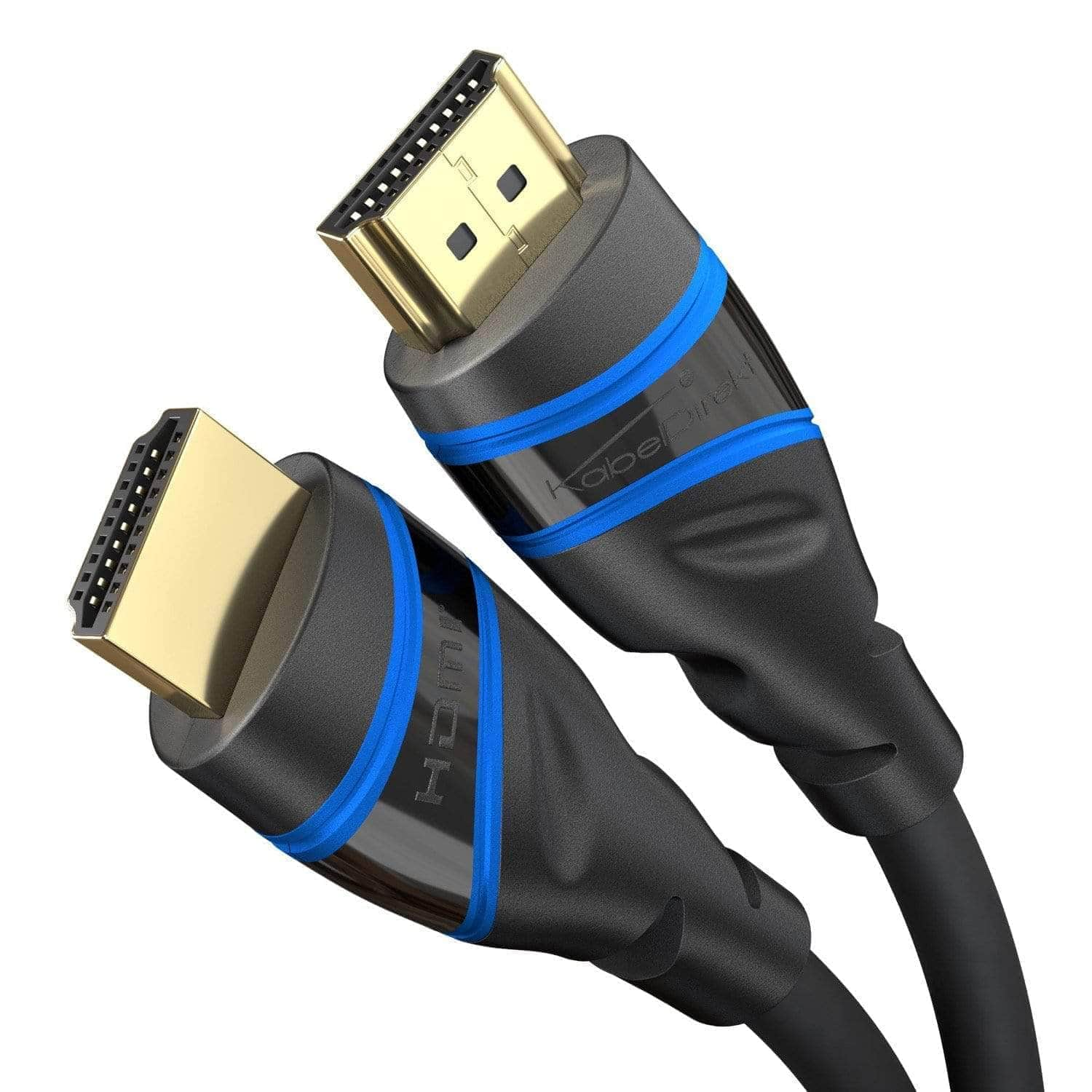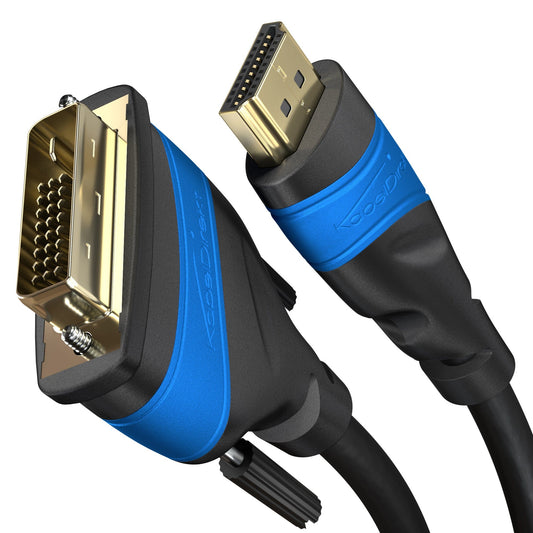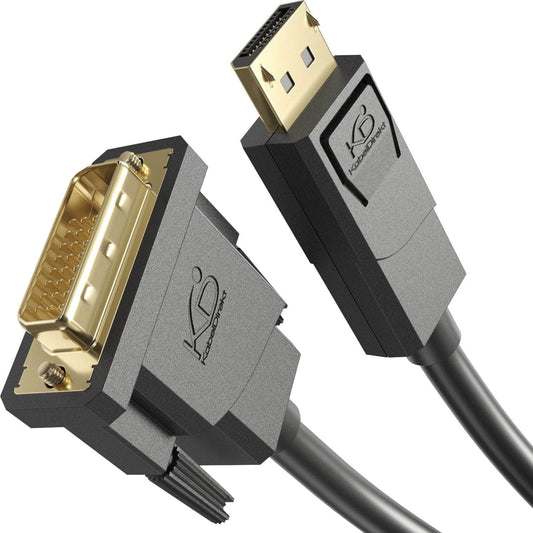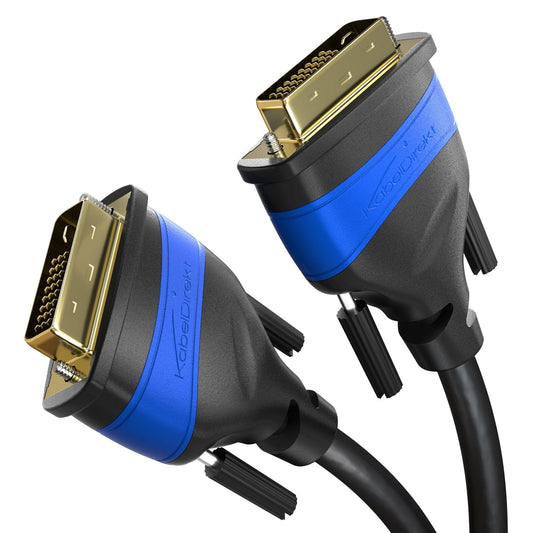-
{# Optional: Hier war bei dir ein zusätzlicher Titelblock; den habe ich entfernt, damit der Titel nur einmal erscheint. #}
-
{# Optional: Hier war bei dir ein zusätzlicher Titelblock; den habe ich entfernt, damit der Titel nur einmal erscheint. #}
-
{# Optional: Hier war bei dir ein zusätzlicher Titelblock; den habe ich entfernt, damit der Titel nur einmal erscheint. #}
Collection: DVI cables
DVI cables: Old, but also tried and tested
DVI stands for Digital Visual Interface and is a video transmission interface that was launched in 1999. Intel, IBM, HP, and other IT companies formed the Digital Display Working Group and created a standard for the digital transmission of video from a video controller to a display device – something that’s still serving us well over two decades later. Read on to learn more.
The DVI family
Most people are probably familiar with DVI cables from the PC sector. For years they were the standard for connecting a monitor to the computer, or more precisely to the graphics card, replacing VGA cables as the number one connection solution. What probably not everyone is aware of though is that there are different types of DVI plugs and sockets: DVI-A, DVI-I, and DVI-D – with the latter two available as single- and dual-link variants.
DVI-A is no longer relevant as it can only transmit analog signals from the graphics card. By contrast, DVI-I can handle both digital and analog signals, whereas DVI-D only handles digital data. One of the key differences between single- and dual-link cables is that one uses only one TMDS transmitter, the other two. As a result, dual-link cables offer twice the bandwidth, which is why they support higher resolutions than their single-link counterparts. But you can also tell them apart just by looking at them: In both cases (i.e. DVI-I and DVI-D), dual-link connectors have six more pins/sockets.
Enjoy the best quality DVI cables
We offer dual-link 24+1 pin DVI-D cables that allow you to connect older monitors or projectors to your PC. And rather conveniently, the cables are compatible with all types of DVI interfaces. They support a maximum resolution of 2560 × 1600 at 60Hz. At Full HD (1920 × 1080), the DVI cables can handle 144Hz. This makes them even suitable for gamers who spend their time playing fast-paced, competitive online games.
You can buy high-quality DVI cables from us in various lengths, from 0.5m to 10m. They all have built-in ferrite cores, which sets them apart from regular DVI cables and provides additional interference suppression during signal transmission. The connectors are gold-plated to protect the cable from corrosion, and the screws on either side of the connectors hold them securely in place so you don’t have to worry about a loose connection.
Connecting DVI to HDMI, DisplayPort, or USB-C
Nowadays it’s likely that either your monitor or your graphics card won’t have a DVI output but only HDMI and/or DisplayPort connector. But don’t worry – we have the solutions to connect your devices with each other. If you have a modern graphics card but an old screen, you’re best off getting a DisplayPort to DVI or HDMI to DVI adapter cable, especially since these cables come with DVI-D connectors (dual link) that you can hook up to any type of DVI interface.
You can even use the HDMI to DVI adapter cable to connect a video game console or DVD/Blu-ray player to an older PC monitor (you’ll need a separate cable for audio transmission). Both cables support resolutions up to 1080p, have high-purity copper conductors, and gold-plated connectors. The HDMI variant can also be used bidirectionally, so you can connect an older graphics card to a modern screen.
If you want to connect your laptop to a monitor or projector with a DVI input, we have a USB-C to DVI adapter in our range. The USB-C adapter supports resolutions of up to 4K (at 30Hz) and is also compatible with MacBooks with Thunderbolt 3.
DVI cable FAQs
What kind of DVI cable do I need for my monitor?
There are five different types of DVI interface (and therefore plugs). The good thing is that dual-link DVI-D cables are compatible with all DVI interfaces, so you can’t go wrong with this type.
Can I connect DVI to HDMI?
With an appropriate adapter cable, like the ones we offer in our shop, this is easy to do.
Which is better: HDMI or DVI?
HDMI is a more modern technology that has come a long way since its introduction in 2002. With HDMI 2.0, for example, you can transmit 4K video (3840 × 2160) at 60Hz, or even at 144Hz with HDMI 2.1. By contrast, DVI maxes out at 2560 × 1600 (60Hz). HDMI can also carry audio, whereas DVI can’t. HDMI is definitely better technically; DisplayPort is also a good choice for modern gaming monitors. But if you happen to own a monitor that only has a DVI and no HDMI port, even the best HDMI or DisplayPort cable won’t be any good.
What resolution can DVI handle?
This differs from single- to dual-link DVI. The former can handle 1920 × 1080, while the dual-link variant supports 2560 × 1600 as it offers twice the bandwidth.
Which is better: VGA or DVI?
VGA is a very old interface that was introduced in 1987 and transmits purely analog data. DVI, on the other hand, supports (apart from DVI-A) the lossless transmission of digital signals, putting it clearly ahead.
What’s the difference between DVI and DVI-D?
There is no "standard" DVI variant. You either have DVI-A, DVI-I, or DVI-D. The latter can only transmit digital signals, whereas DVI-A is purely analog and DVI-I can do both.
What’s a dual-link DVI connector?
A dual-link DVI connector has either 24 + 5 (DVI-I) or 24 + 1 sockets (DVI-D), and any DVI plug is compatible with a DVI-I connector. That’s why there used to be graphics cards with dual-link DVI connectors, even though they couldn’t drive resolutions beyond 1920 × 1080. The advantage of dual-link cables is that they support resolutions of up to 2560 × 1600, provided the graphics card can handle it.

HDMI Cables
We offer HDMI cables in all versions, lengths, and materials. Our products are engineered in Germany and manufactured worldwide in licensed facilities.




